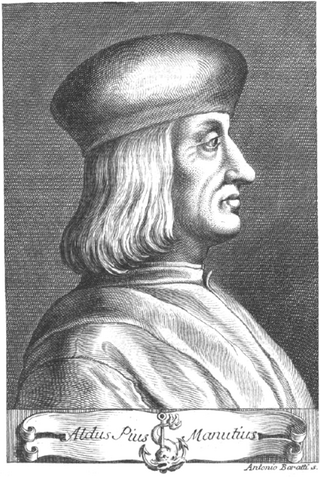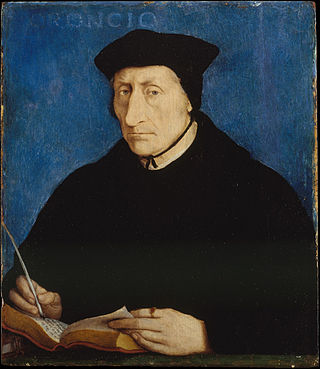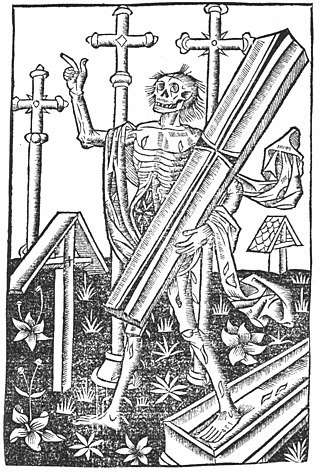
The Aldine Press was the printing office started by Aldus Manutius in 1494 in Venice, from which were issued the celebrated Aldine editions of the classics. The first book that was dated and printed under his name appeared in 1495.
The semicolon; is a symbol commonly used as orthographic punctuation. In the English language, a semicolon is most commonly used to link two independent clauses that are closely related in thought, such as when restating the preceding idea with a different expression. When a semicolon joins two or more ideas in one sentence, those ideas are then given equal rank. Semicolons can also be used in place of commas to separate items in a list, particularly when the elements of the list themselves have embedded commas.

Aldus Pius Manutius was an Italian printer and humanist who founded the Aldine Press. Manutius devoted the later part of his life to publishing and disseminating rare texts. His interest in and preservation of Greek manuscripts mark him as an innovative publisher of his age dedicated to the editions he produced. Aldus Manutius introduced the small portable book format with his enchiridia, which revolutionized personal reading and are the predecessor of the modern paperback book. He also helped to standardize use of punctuation including the comma and the semicolon.

Guillaume Budé was a French scholar and humanist. He was involved in the founding of Collegium Trilingue, which later became the Collège de France.
This article is a list of the literary events and publications in the 15th century.
This article presents lists of literary events and publications in the 16th century.
This article contains information about the literary events and publications of 1574.
Polydore Vergil or Virgil, widely known as Polydore Vergil of Urbino, was an Italian humanist scholar, historian, priest and diplomat, who spent much of his life in England. He is particularly remembered for his works the Proverbiorum libellus (1498), a collection of Latin proverbs; De inventoribus rerum (1499), a history of discoveries and origins; and the Anglica Historia, an influential history of England. He has been dubbed the "Father of English History".

Circassia, also known as Zichia, was a country and a historical region in the North Caucasus. Located along the northeastern shore of the Black Sea, it was conquered by the Russian Empire during the Russo-Circassian War (1763–1864), after which approximately 90% of the Circassian people were either exiled or massacred in the Circassian genocide.

In folklore, a revenant is a spirit or animated corpse that is believed to have been revived from death to haunt the living. The word revenant is derived from the Old French word revenant'returning'.

The Italian Wars of 1499–1504 are divided into two connected, but distinct phases: the Second Italian War (1499–1501), sometimes known as Louis XII's Italian War, and the Third Italian War (1502–1504) or War over Naples. The first phase was fought for control of the Duchy of Milan by an alliance of Louis XII of France and the Republic of Venice against Ludovico Sforza, the second between Louis and Ferdinand II of Aragon for possession of the Kingdom of Naples.

The House of Giustiniani was a prominent Italian family which originally belonged to Venice, but also established itself in Genoa, and at various times had representatives in Naples, Canary Islands, Corsica and in the islands of the Archipelago, where they had been the last Genoese rulers of the Aegean island of Chios, which had been a family possession for two centuries until 1566. The family claimed descent from Byzantine emperor Justinian I.
Giosafat Barbaro (1413–1494) was a member of the Venetian Barbaro family. He was a diplomat, merchant, explorer and travel writer. He was unusually well-travelled for someone of his times.

The Bank of Saint George was a financial institution of the Republic of Genoa. It was founded in 1407 to consolidate the public debt, which had been escalating due to the war with Venice for trading and financial dominance. The Bank's primary mission was to facilitate the management of the San Giorgio shares (luoghi). It was one of the oldest chartered banks in Europe and of the world. The Bank's headquarters were at the Palazzo San Giorgio, which was built in the 13th century by the order of Guglielmo Boccanegra, uncle of Simone Boccanegra, the first Doge of Genoa. On June 11, 1857 the ancient lock from the vault of the bank of St George was presented to the Philadelphia historical society by Lieutenant George H. Hare USN.

Giovanna Ralli,, is an Italian stage, film, and television actress.

Carlo di Cosimo de' Medici was an Italian priest. A member of the powerful Medici family, he became a senior clergyman and collector.
Thomé Lopes was a Portuguese scrivener, writer of an eyewitness account of the second journey of Vasco da Gama to India (1502–1503).
Urbano Dalle Fosse, better known as Urbano Bolzanio, was an Italian humanist and Hellenist.

Giovanni Battista Cipelli (1478–1553), better known as Egnazio, was a Venetian priest and humanist. He came to public notice through his rivalry with Marcantonio Sabellico in 1500–1506. From about 1508 until 1520 he was involved in the teaching and publishing endeavours of Aldo Manuzio and his successors. From 1520 until 1549, he held a public professorship in Venice. Upon his retirement, he was granted a full pension.











